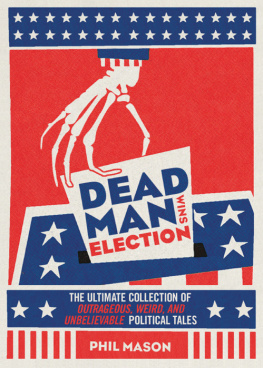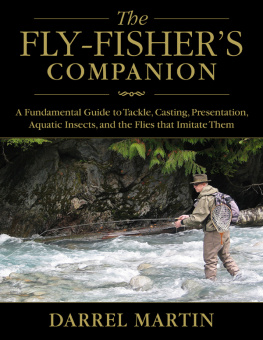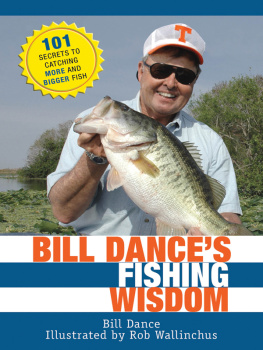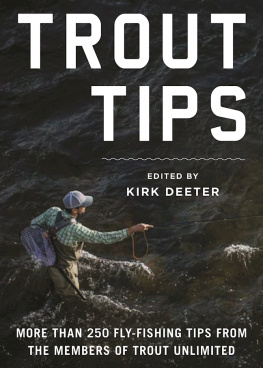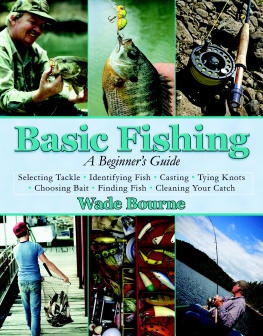Sports Illustrated
FLY FISHING
Learn from a Master
Sports Illustrated Winners Circle Books
BOOKS ON TEAM SPORTS
Baseball
Basketball
Football: Winning Defense
Football: Winning Offense
Hockey
Lacrosse
Pitching
Soccer
BOOKS ON INDIVIDUAL SPORTS
Bowling
Competitive Swimming
Cross-Country Skiing
Figure Skating
Golf
Racquetball
Running for Women
Skiing
Tennis
Track: Championship Running
Track: The Field Events
SPECIAL BOOKS
Backpacking
Canoeing
Fly Fishing
Mountain Biking
Scuba Diving
Small-Boat Sailing
Strength Training
Training with Weights

This book is dedicated to my father, Bill Sr., who bought me my first fishing equipment and took me fishing, and to my mother, Mary, who presented a camp that would be the envy of any outfitter
Acknowledgments: To Kathy Gyurkey, for her transcribing help. To Charlie and Lynn, for their modeling, and to Liza Paschall, for her patience while being photographed performing fishing techniques. And to all the outfitters, guides, customers, and friends in West Yellowstone, Island Park, and Sun Valley, who, over the course of 19 years, contributed in their own small way to this book. Special thanks, too, to John Merwin at the American Museum of Fly Fishing, Manchester, Vermont; Farrow Allen and Charlie Lovett at the Fly Fishing Shop, Winooski, Vermont; Bill Alley at the Fly Rod Shop, Stowe, Vermont; Tom Rosenbauer and Howard Steere at Orvis, Manchester, Vermont; Barry Staats and Judy Laurie at The Sporting Gentleman, Media, Pennsylvania; Dan Shields, Steve Sywensky, Dave McMullen, and Bernard Robb at Flyfishers Paradise, Lemont, Pennsylvania; Joe McMullen at the Spruce Creek Trout Farm, Lemont, Pennsylvania; and Tom Forwood at Eylers Inc. Fly & Tackle, Bryn Mawr, Pennsylvania.
Picture credits: Pages courtesy of the Museum of American Fly Fishing, Manchester, Vt.; 202 by Dick Leyden; 213 by Fred Arbona Jr.; 192, 201 by Pam Jaspersohn; 209, 214, 215 by David Stoecklein. All drawings by Dick Leyden. All other photographs by Bill Eppridge.
Copyright 1988, 1994 by Time Inc.
All rights reserved. No part of this book may be reproduced in any form or by any electronic or mechanical means, including information storage and retrieval systems, without written permission from the publisher, except by a reviewer who may quote passage in a review.
FIRST SPORTS ILLUSTRATED BOOKS EDITION 1994
Sports Illustrated Flyfishing: Learn from a Master was originally published by Time, Inc. in 1988.
Sports Illustrated Books
An imprint of Madison Books, Inc.
Lanham, MD 20706
Distributed by National Book Network
Library of Congress Cataloging in Publication Data
Mason, Bill, 1929
Sports Illustrated fly fishing.
(Sports illustrated winners circle books)
Bibliography: p.
1. Fly fishing. I. Sports illustrated. II. Title. III. Title: Fly fishing. IV. Series.
SH451.M388 1988 799.1755 8736948
ISBN 978-1-56800-033-6
Contents
Sports Illustrated
FLY FISHING
Learn from a Master

The author practicing what he preaches on Idahos famed Silver Creek.
Introduction: Why Fish the Fly?
Why people pursue fly fishing rather than other fishing methods has probably been the most debated question concerning the sport. There is no definitive answer to this question. One persons attraction may not be anothers, but certain common bondsa love of the outdoors, a passion for understanding various species, and a patience born of deep feeling for the beautiful complexity of the sportunite all fly fishermen.
Under my fathers tutelage I began as an angler when I was six. I have fished the fly every season since, and my love for it continues to grow unabated. I cant seem to get enough of fly fishing, and when the season for it ends in Sun Valley, where I live, I find myself packing my gear to fish the fly in other parts of the world. What is it about the sport that draws us so completely to it?
Essentially, fishing as a pastime is a game, and the sport of fly fishing is its pinnacle. In all games we have an opponent and in the sport of fishing the opponent becomes the fish itself. Because this incredible adversary neither lies nor cheats but rather reacts upon its own instincts for survival, the intrigue of angling for it on equally honest terms runs deep.
For most people, the fishing game starts at an early age, simplified in form and technique. A fishing pole, a plain line, a pocket full of hooks and sinkers, and a coffee can filled with night crawlers or grasshoppers generally starts the game in motion. But after awhile, something begins to happen. Through observation of fish habits and, perhaps, an inherent desire to make the game more complex, the angler slowly turns his attention toward the fly rod and the insects so attractive to the fish. By becoming a fly fisherman, the angler discovers he has entered a world and a game that can consume him for the rest of his life. Dealing as it does with Nature and her creatures, the sport of fly fishing is always variable, never constant, and the angler alert to its variations learns something new on every outing. Indeed, the daily subtle changes that the angler faces are one reason why the appeal of fly fishing is so great for so many people.
The knowledge gained through fly fishing holds special appeal, too. A good fly fisherman finds himself becoming an amateur ichthyologist studying fish, a hydrologist analyzing water, an entomologist identifying insects, and a meteorologist recognizing weather patterns. All these subjects require a lifetime of attention and study, but the quest for knowledge is one of the sports continuing attractions.
Fly fishing has often been described as an art form. In other methods of fishing, the weight of lure, plug, or bait propels the cast. In fly fishing, the motion of the rod casts the fly line and the line, in turn, the fly. Placing the fly exactly where it should go requires precision and skilland more delicacy and touch than does any other casting method. In fly fishing, as we shall see, the presentation of the flythat is, the manner in which it is laid on the water and made to actis at least as important as the choice of the fly. The chuck and chance technique so often characteristic of other casting methods wont work for the fly fisherman. He must put in the hours to perfect both his casting and his presentation techniques.

In other fishing methods (lower illustration), the weight of the lure, plug, or bait propels the cast. In fly fishing (upper illustration), the motion of the rod casts the fly line, which, in turn, casts the fly.
Most fly fishermen ultimately become more interested in the method than in the final outcome of fishing the fly. They rapidly acquire a quiet admiration for the fish they hunt, and they come to realize that to kill it is to kill the very thing that keeps them coming back to the water. It becomes more important that the fish survive to be hooked againand againfor it is in the hunting, stalking, and deceiving that the satisfaction lies, not in the keeping and killing.
Next page




